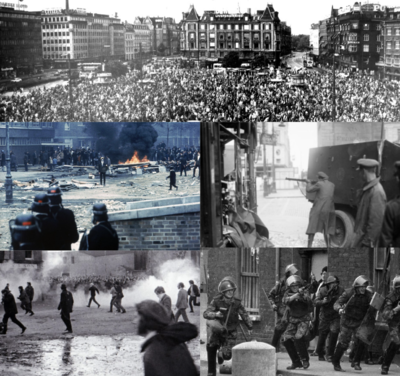Gjorkan Resistance
| Gjorkan Resistance | |||||||||
|---|---|---|---|---|---|---|---|---|---|
 Protests in Nomakoa demanding an end to the Dictatorship, Skirmish in early Resistance Period between Government and Socialist Forces, Police Forces putting down a riot in Rusynia, People running from Government Forces during the Peace Day Massacre, Explosion in Gjorka City from a car bomb set off by Golden Dawn. | |||||||||
| |||||||||
| Belligerents | |||||||||
|
Supported by: | |||||||||
| Commanders and leaders | |||||||||
|
|
|
|
| ||||||
The Gjorkan Resistance was an insurgency of various anti-government groups against the Military Dictatorship of Gjorka that lasted 53 years from November 11th 1919 to November 11th 1972. The insurgency began following the end of the Second Gjorkan Civil War, and the surrender of last remaining major socialist forces. Various socialist and loyalist groups throughout Gjorka however did not end their fight. The early phase of the Gjorkan Resistance is known as the War against Socialism as the Government hunted down the remaining opposition groups. However, the conflict expanded to a larger resistance movement following the government's decision to delay elections until further notice in 1923.
The resistance had various phases of conflict heating up, and cooling down. However, by 1971 the democratic resistance had gained significant public support, and Government efforts to supplants the rebel groups were starting to fail. This all came to a head with the death of President MacRoy, and subsequent 1971 Gjorkan coup d'état by Austin Tannerburg. However, Tannerbug's rule was not universally accepted and many other military units across the country mobilized to overthrow him. In order to have a fighting chance, Tannerburg publicly declared support for a restoration of Gjorkan Democracy, despite privately wanting to continue a dictatorship under his rule. Gjorkans flooded the street, in celebration of the news and military units across the Republic faced mass desertions. This event known as the Black Revolution caused a cease fire between most major rebel groups and the government, and the eventual return of Gjorkan democracy a year later on November 11th, 1973 (53 years to the day of the end of the Second Gjorkan Civil War) leading to the end of the resistance.
